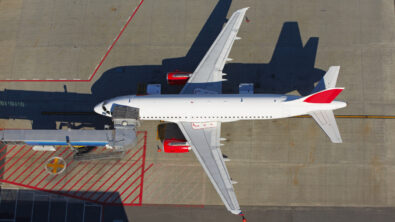Podcast: Exploring AI for the aerospace industry

Recent developments in artificial intelligence (AI) are offering exciting opportunities across industries, including aerospace. As the technology seems to evolve and mature faster than ever, companies need to stay on top of AI developments and assess how it can improve efficiency and aid key functions.
Todd Tuthill, vice president of aerospace, defense and marine for Siemens Digital Industries Software, recently joined the SAE Tomorrow Today podcast with Grayson Brulte to talk about AI in aerospace. They covered topics including:
- AI as an optimization tool within organizations
- AI’s place in digital transformation
- The impact of generative AI on product development
- How companies should think about implementing AI into their workflows
Check out an excerpt of the episode transcript below for a preview of the topics discussed. Then, visit the SAE Tomorrow Today Podcast page to listen to the full episode and view the entire transcript.
Episode preview: How AI is redefining the aerospace industry
This portion of the podcast transcript has been lightly edited for clarity.
Grayson Brulte: How is Siemens using AI to make products better? Is it on a per-product basis? Is it an overall corporate strategy? How are we using it to make products better?
Todd Tuthill: We’re doing it in several ways. Again, if you think about the different aspects of AI, we talked about large language models and chat GPT, but let’s talk about several other things that we can do with AI right now today. We can talk about topology optimization. We can talk about optimization of simulations. We can talk about generative design because people think of generative design sometimes like Skynet and okay, we’re going to enter a prompt, and an airplane’s going to pop out, and we’re not quite there yet.
But there are several things we can do with respect to generative design and designing aspects of a product. It might be an electrical wiring design. It might be a mechanical part, or it might be a support material for one of those things. So certainly, that’s an aspect of things or maybe an expert system, and we’re applying each of those things to several of our products and maybe some of the less sexy things.
One of the really important things I think we’re doing with products is using predictive algorithms to understand what’s the next task you want to do with one of our key tools. As you, anyone would know if you used key sophisticated design tools, sometimes the hard part is knowing what to do next.
And AI can really, we’ve embedded that kind of AI knowledge into a number of our key tools to say, “Here’s the way a subject matter expert might work.” And then, it can also watch you work and start to predict the next tool based on the tool flow that you’re in. These assistive technologies, and I’d like to say that while we do generative things, and I think we’re just at the beginning of AI, I really see a big part of what we’re doing with AI right now is assistive. It’s taking what you do every day and making what you do every day easier and more efficient.
Grayson Brulte: From the aerospace angle, you’re working on an aircraft, does that impact the [Federal Aviation Administration] certification that AI was used as part of that? Do the flags go up? Hey, wait a second. Anything there?
Todd Tuthill: Any tool that you use in the certification of an aircraft is subject to FAA approval.
But we’re not to the point yet where we’re completely doing the end-to-end design and validation of a product completely with AI. In other words, we’re not pushing a button, and the airplane wing falls out. So I think from an FAA perspective, I don’t see any difference between AI and what we do with AI right now or any great difference there with respect to the FAA, than I would with a simulation tool.
It’s just another tool in the toolbox. And to use that tool, there are things that are required on the part of the FAA to understand the validity of what that tool produces. And at the end of the day, the output of that tool has to be inspected and understood by a real human engineer before it’s allowed to pass on and be a part of the type certs for an aircraft or for the things that the FAA might require.
Grayson Brulte: Staying on the tool and toolbox angle. What does AI enable you to unlock as it’s for the development of aircraft today that was not possible before the development of AI when you started using it 10 years ago?
Todd Tuthill: Wow. We don’t have enough time on your podcast to go through all of those things, but we can talk. And I mentioned a few of them, but let’s talk about a few things AI can do right now today. We have the ability today, and it’s one of the things, quite frankly, that I’ve wanted to do for a while in engineering. If we think about the process of creating things, what engineers do, and I go back to my time as director of engineering in previous companies, and I would watch what my engineers would do all day. And I think about the time I was in school, when engineers went to school, and we had these grand ideas in our mind about what engineering would be like. I’m going to come out of school, and I’m going to think these big thoughts, and I’m going to do all these fantastic, innovative things.
And the reality that most engineers, the reality I found, that most engineers find, is that engineers spend a lot of their time doing really mundane things. They spend their time searching for information, preparing reports, putting things together. And one of the key things AI is doing now that it couldn’t do maybe three or four years ago is it’s doing a lot of this mundane work. So imagine the time it takes to assemble a bunch of information from a bunch of testing that you’ve done and write a test report, and I can do that for you today.
Another use case that we have customers using right now with our tools – I can take an architecture from an architecture tool, and I can take that fundamental architecture and generatively create a design for a wiring system from that. And all the tedious aspects of point-to-point wiring, we can do a lot of that generatively now.
Once you have that wiring design, then I can take another step further, and I can create all the materials that it might take to manufacture that wiring design, or maintain that over the life of an aircraft. Again, a lot of tedious things. And we have customers saving thousands of hours of tedious work of creating that documentation.
And, again, maybe it’s not quite as sexy as Skynet – push a button, and it falls out the other end – but it is sexy if you’re a CFO, and you’re thinking about the time and money invested in what it takes to create these kind of aerospace products because there’s a whole lot of time still spent on doing all the paperwork and really the time thinking the big thoughts that we all talked about as engineers.
Engineers spend a good part of their time doing mundane tasks, and I think the key thing AI’s allowed us to do in the past few years is really take on a lot of those mundane things. So that’s the one hand, and there are some cooler things too that maybe we’ll get to later in the podcast, but that’s the heart of what I see AI doing for a lot of things in engineering right now.
Listen to the full podcast episode for more.
Want to dive deeper on AI in aerospace? The Siemens Talking Aerospace Today podcast recently released episodes on potential applications for AI in aerospace. Don’t miss part one and part two.


